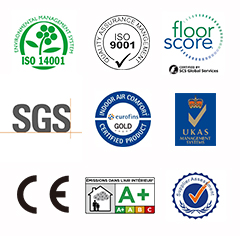Most popular Vinyl Flooring in the Kitchen
When it comes to redoing floors in your home, you have a wide variety of options to choose from. If you’re looking at remodeling your kitchen, specifically, you certainly want to choose a kitchen floor that’s durable, but also pleasing to the eye. Add affordability to the mix and one of the best options you’ll find is vinyl flooring. Vinyl flooring has become an increasingly popular floor choose for homeowners, and it’s easy to see why.
But with any choice, there are pros and cons to be considered before moving forward with this type of flooring. Here are the top vinyl flooring pros and cons.



What is Vinyl Flooring?
Before we overview vinyl flooring pros and cons, it may be helpful to understand the origins of vinyl flooring. Originally invented in the 1930s, vinyl flooring first made an impact on the architectural world in the years following World War II, and by the 1950s had become a major competitor against other flooring options, specifically linoleum (which up until that point had been considered the best low-cost water-resistant flooring option for kitchens and bathrooms).
And the popularity of vinyl flooring has only been steadily trending upwards since then. According to DoItYourself.com, vinyl still accounts for around 15 percent of annual flooring expenditures in the country.



What is Vinyl Flooring?
Before we overview vinyl flooring pros and cons, it may be helpful to understand the origins of vinyl flooring. Originally invented in the 1930s, vinyl flooring first made an impact on the architectural world in the years following World War II, and by the 1950s had become a major competitor against other flooring options, specifically linoleum (which up until that point had been considered the best low-cost water-resistant flooring option for kitchens and bathrooms).
And the popularity of vinyl flooring has only been steadily trending upwards since then. According to DoItYourself.com, vinyl still accounts for around 15 percent of annual flooring expenditures in the country.
One of the biggest draws of vinyl flooring is the durability – specifically its resistance to water. Most vinyl flooring is 100% moisture-resistant. This element alone makes it ideal for use in kitchens, as well as bathrooms and even basements.
Compared to other flooring options, vinyl is much better at sealing against water damage than laminate and hardwood.
Vinyl is generally considered to be a highly durable material. If well-taken care of, your vinyl floors can last anywhere between 10 and 20 years.
Another durability “pro” of vinyl is that many types of vinyl are composed of individual pieces that can easily be replaced if damaged. This more the case with plank or tile vinyl, since the pieces are smaller.



A popular choice for kitchens, this resilient flooring is a versatile, economical option. Vinyl comes in a wide range of colors and patterns that mimic hardwood, ceramics, and stone. The surface's elasticity and warmth make it comfortable to stand on, and plates, cups, and glasses often won't break when dropped.
Unlike the dated floors of past generations, today's vinyl features better textures and colors for a more realistic appearance, thanks to improvements in the rotogravure (engraving) process for the surface. You can buy vinyl with textures that look like slate, leather, even wood.
What You Need to Know
The Lowdown: Vinyl is composed of four layers: a protective urethane top coat, a protective clear vinyl layer, a printed design layer, and a felt or fiberglass backing.
Tough Enough? Vinyl is a durable surface that shouldn't stain, scratch, or fade. Vinyl—especially the luxury styles—can handle spills, kids, and pets with ease. May types are imbued with antimicrobial protection to fight bacteria, mold, and mildew.
How to Clean: Wipe up spills immediately. Sweep, dust, or vacuum regularly, and occasionally wipe the surface with a damp mop or cloth. For glossy floors, occasionally strip and reapply polish as necessary. Avoid waxing or buffing the surface.



Considerations When Choosing Vinyl Flooring
Vinyl flooring comes in three basic forms.
Vinyl Sheets. Offer a seamless look and comes in a variety of colors, designs, and patterns.
Vinyl Tiles. Emulate ceramics and can be arranged in any pattern. Some manufacturers now offer vinyl tiles that can be used with color-coordinated grout, making them look even more like tile.Many homeowners prefer vinyl tile, which replicates the look of a ceramic tile floor at a more affordable cost.
Vinyl Planks. Look like hardwood, with realistic colors and textures. Vinyl planks can mimic distressed surfaces or exotic species, and have beveled edges.
Underlyament. With proper prep, vinyl can be installed over virtually any flat, dry, clean surface. In most cases, a plywood underlayment is recommended for the best results.




